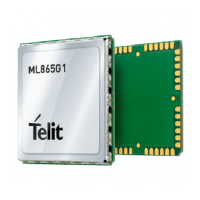
Do you have a question about the Telit Wireless Solutions ML865G1 and is the answer not in the manual?
| Module Type | LTE Cat M1/NB1 |
|---|---|
| Operating Temperature | -40°C to +85°C |
| Interface | UART, GPIO |
| Power Supply | 3.4V - 4.2V |
| GNSS | GPS, GLONASS |
| Certifications | CE, FCC |
Lists all pins of the ML865G1 module with their signals, I/O direction, function, type, and comments.
Illustrates the physical pin layout of the ML865G1 module from a top-view perspective.
Outlines the nominal and operating voltage requirements for powering the ML865G1 module.
Details the power consumption of the ML865G1 module in various modes, including Idle and Connected.
Provides principal guidelines for power supply design, covering electrical, thermal, and PCB layout aspects.
Details electrical design considerations for power supply based on input source types (+5V, +12V, Battery).
Details the procedure for turning on the ML865G1 module using the ON_OFF/WAKE pin.
Describes the two methods for turning off the ML865G1 module: via AT command or the ON_OFF/WAKE pin.
Explains the use of the HW_SHUTDOWN* pin for an unconditional shutdown and reset of the module.
Lists the available communication interfaces, including USB and serial ports.
Details the integrated USB 2.0 High-Speed transceiver and its associated signals.
Describes the standard 3-wire SPI interface provided by the ML865G1 module for master or slave operation.
Details the two asynchronous serial ports (Modem Serial Port 1 & 2) available on the ML865G1 module.
Describes Modem Serial Port 1 (USIF0) as a +1.8V UART with all 7 RS232 signals.
Describes Modem Serial Port 2 (USIF1) as a secondary serial port with RX and TX signals.
Explains the need for level translation when interfacing the ML865G1 with PC COM ports or RS232 applications.
Introduces the set of configurable Digital Input/Output pins (GPIO) available on the ML865G1 module.
Outlines crucial requirements for antenna connection and PCB transmission line design for optimal performance.
Provides guidelines for designing the PCB transmission line connecting the antenna to the ML865G1.
Specifies the requirements for GNSS active antennas, including frequency range, gain, and impedance.
Lists detailed specifications for GNSS antennas, including gain, impedance, noise figure, and VSWR.
Shows the recommended PCB footprint and pad layout for surface mount assembly of the ML865G1.
Details the recommended solder reflow profile and parameters, including warnings about optimization.
Emphasizes critical safety precautions for using the product, including environmental restrictions and handling.